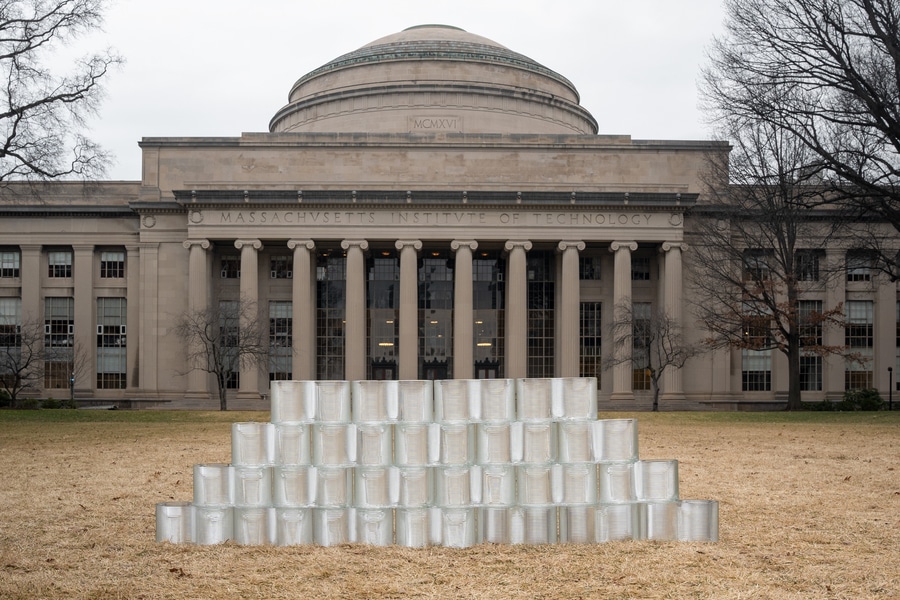Friday 18th October 2024
Friday 18th October 2024

Imagine if construction materials could be assembled and disassembled as effortlessly as LEGO bricks. This concept of reconfigurable masonry would enable buildings to be taken apart at the end of their lifecycle and reassembled into new structures, promoting sustainability by reusing the same physical materials across generations. This idea underpins circular construction, which aims to reuse and repurpose materials to reduce the need for new production and minimize “embodied carbon,” the greenhouse gas emissions linked to the entire construction process, from material creation to demolition.
Motivated by the eco-friendly potential of circular construction, MIT engineers are developing reconfigurable masonry made from 3D-printed, recycled glass. Using a custom 3D glass printing technology from MIT spinoff Evenline, the researchers have created sturdy, multi-layered glass bricks shaped like figure eights, which can interlock in a manner similar to LEGO pieces.
Mechanical testing of these glass bricks showed they could withstand pressures comparable to concrete blocks. As a proof of concept, the researchers built a wall of interlocking glass bricks, demonstrating the potential of reusable glass masonry for constructing facades and internal walls. According to Kaitlyn Becker, assistant professor of mechanical engineering at MIT, glass is highly recyclable and offers a sustainable solution for construction. Once a structure reaches the end of its useful life, the glass bricks could be dismantled and reused in a new building, or melted down and reshaped into a different form.
Michael Stern, a former MIT graduate and founder of Evenline, notes that using glass as a structural material is unconventional, but the project pushes the boundaries of architectural design. The research team, including Becker, Stern, and others, detailed their design in a study published in Glass Structures and Engineering.
The inspiration for this innovation partially stems from MIT’s Glass Lab, where Becker and Stern initially learned the craft of glassblowing. Stern later designed a 3D printer that could print molten, recycled glass, an idea that led to the development of this glass masonry. Becker, now a faculty member, focuses on combining innovative design with advanced manufacturing processes. She finds glass intriguing due to its optical properties and recyclability; as long as it remains uncontaminated, glass can be recycled indefinitely.
The research team collaborated to explore how 3D-printed glass could be shaped into masonry units that are as strong and stackable as traditional bricks. They used Evenline’s latest glass printer, G3DP3, which melts crushed glass bottles into a printable form. This printer deposits the molten glass in layered patterns to create bricks with two round pegs, resembling LEGO studs, which allow the bricks to interlock and form larger structures. An additional material is placed between the bricks to prevent scratches or cracks but can be removed if the structure is dismantled and recycled. This removable material also enables the bricks to be remelted and reshaped into new forms.
The team designed the bricks in a figure-eight shape, which allows for secure interlocking while enabling the construction of walls with curvature. After printing the glass bricks, the researchers tested their mechanical strength using an industrial hydraulic press. They found that the strongest bricks, made mostly from printed glass, could withstand pressure levels comparable to those endured by concrete blocks. These bricks also featured interlocking elements made from a different material that could be attached to the bottom of each brick.
Although glass is a challenging material to work with, Becker and the team see promise in their design, particularly in the potential of using different materials for the interlocking features. They aim to refine their design further to see if more of the interlocking elements can be made from printed glass. However, this is not seen as a major obstacle in scaling up the design.
To showcase the potential of glass masonry, the team constructed a curved wall using the interlocking bricks. Their next goal is to build progressively larger, self-supporting glass structures, starting with a pavilion — a temporary structure that can be reconfigured into different designs. Stern envisions a future where these reusable glass blocks could be part of many building projects, extending their lifespan through multiple reuses and configurations.
This innovative approach could represent a major shift in construction, offering a sustainable solution that reduces waste and greenhouse gas emissions while reusing materials indefinitely.
Unlock the future of production with 3DX Additive Manufacturing! Whether you need rapid prototyping, custom parts, or low-volume production, our cutting-edge 3D printing solutions are designed to transform your ideas into reality. From advanced materials to the latest in 3D printing technologies, we deliver precision, efficiency, and unmatched quality.
Ready to take your business to the next level? Contact 3DX today to explore how our additive manufacturing services can revolutionize your operations!